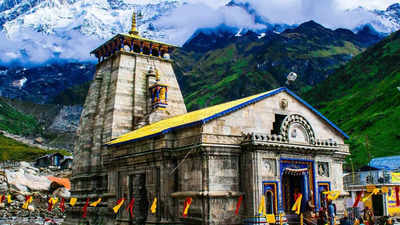1,200-year-old Kedarnath mystery: What lies behind its secrets? |

The Kedarnath Temple, located in Uttarakhand, nestled in the Garhwal Himalayas at a staggering high elevation of 11,755 ft (3,583 m), is counted among the holiest pilgrimage sites in Hinduism. The temple is dedicated to Lord Shiva and forms an important link in the five temple chain called the Panch Kedar. Besides being a spiritual site of great significance, famed for its intricate sculptures and massive monumental form, the temple is also a fine example of ancient Indian architecture.
Kedarnath temple’s origins remain unresolved despite various theories
The mystery surrounding the origins of Kedarnath has ensured that it is an unsolved subject of great interest among scholars and pilgrims alike. Although it is over 1,200 years old, no firm evidence can place its origins at any particular point in time. The opinions about its origins vary widely, with two of the most likely stories saying that the temple was either built by the Pandavas of the Mahabharata or was built during the 8th century by Adi Shankaracharya, a revered philosopher and saint.
It is believed that the temple was built on the site where the Pandavas were trying to gain the blessings of Lord Shiva after the great war. To avoid them, Lord Shiva is said to have taken the form of a bull and plunged into the earth, the hump being manifested at Kedarnath. Such mythological inter-linkages and the doubt looming over the construction dates add icing to the enigmatic cake that is Kedarnath. In modern times, carbon-dating and other scientific parameters have failed utterly to ascertain the time of the temple’s construction, fueling more controversies and explorations.
Kedarnath Temple’s remarkable stone structure withstands centuries of natural disasters
The artistic style of constructing Kedarnath Temple has stood out as an engineering wonder and continues to leave an impression on all its visitors. The temple is mainly built of big stones brought down from the Himalayas around. What makes this construction interesting is that it has stacked the stones without binding agents like cement. This technique has undoubtedly helped to carry the temple through the centuries as per reports. Such unparalleled engineering is evidence of the capabilities of the temple builders of antiquity, but it also speaks volumes about the temple’s capability to withstand the extremes of weather and earth tremors in the area.
The robust structure of Kedarnath Temple has enabled it to endure during numerous earthquakes, heavy snowfalls, and other natural hazards throughout history. The intricate carvings and sculptures embellishing the walls of the temple would have further heightened its beauty, illustrating the culturally and spiritually rich heritage of the time. Architecturally, the temple follows the traditional Hindu temple design with a pyramidal spire and a sanctum (garbhagriha) that houses the primary idol of Lord Shiva.
Kedarnath Temple’s miraculous survival during the 2013 Uttarakhand floods strengthens faith
In its modern history, perhaps one of the most dazzling events in the life of Kedarnath Temple was witnessed in the 2013 Uttarakhand floods. According to the reports, the floods ravaged the earth, causing unspeakable death and destruction, mostly demolishing all the infrastructure in their path, barring, however, the Kedarnath Temple, which withstood the fury. The extraordinary survival of the temple perhaps induced many to believe that it was the almighty who intervened in its merriment.
As local folklore states, a large boulder named Bhim Sheela allegedly lodged itself behind the temple, turning aside the floodwaters and preventing it from becoming engulfed. Such an incident is viewed by many devotees as promising protection from Lord Shiva, strengthening their faith in the temple being holy and bathed in divine protection.
Kedarnath Temple’s role in the Panch Kedar and its significance in Hindu legend
Kedarnath Temple is an important temple of the Panch Kedar, which is anciently linked with Hinduism. The legends describe the steps to obtain forgiveness for the woes perpetrated during the Kurukshetra war. The Pandavas, seeking God’s blessings, chased Shiva, who thus metamorphosed into a Nandi bull to evade them. As the chasing went on, he gave up parts of his body, resulting in five temples with each site having a religious significance:
- Kedarnath: Hump of the bull hid here.
- Tungnath: Bull showed its arms here.
- Rudranath: Bull’s face is associated with this temple.
- Madhyamaheshwar: Bull’s navel appeared here.
- Kalpeshwar: Bull’s hair appeared here.
Hence, these temples form the revered Panch Kedar with a common journey for devotees who seek Lord Shiva’s blessings and forgiveness.
Kedarnath Temple: A six-month pilgrimage and the challenging trek to the divine
Given that Kedarnath Temple is not easily approachable, the pilgrimage is thus an arduous and physically-trying journey. Due to extreme weather conditions, Kedarnath remains open for pilgrims only for six months a year, from April through November. Heavy snowfall and severe conditions border on the closing of Kedarnath temple in winters. Then, the idol of Lord Shiva is taken 26 km south to the Omkareshwar Temple at Ukhimath, where it remains worshipped daily to ensure that the connection of spiritual energy continues uninterrupted throughout the year.
The journey to Kedarnath shall take nearly 16 kilometers (10 miles) of a steep uphill trek from Gaurikund, which is the nearest accessible point by road. Pilgrims usually trek on foot, and at times, horses and palkis (palanquins) are arranged for those who cannot walk. The tough terrain and high-altitude location together make this pilgrimage a test of physical endurance and devotion.
Also Read | “I am become meme”: Elon Musk describes Doge’s transformation from meme to currency as ‘crazy but cool’ | Watch
















